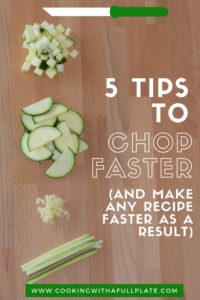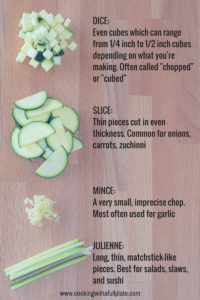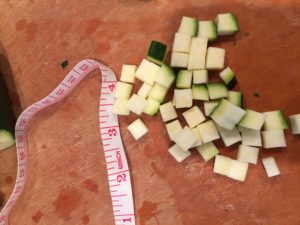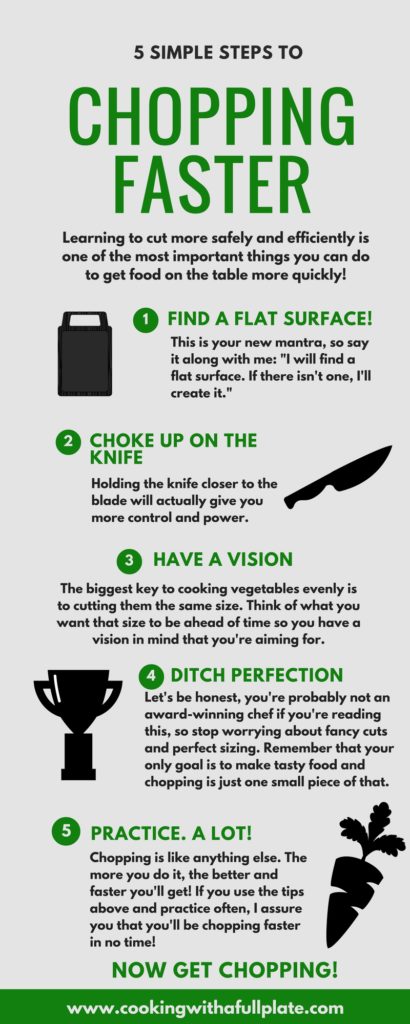Let’s be honest. You’re a busy lady (or gentleman). Most nights you don’t even have time to figure out what to make for dinner, let alone shop for the ingredients, chop them up, cook them and get it on the table before the kids (or you) are hangry.
This is probably why you’ve turned to meal boxes like Blue Apron or Hello Fresh. Or perhaps you’re constantly searching Pinterest for “fast, easy dinners.” Or you’re gritting your teeth and spending hours meal prepping at the beginning of the week so that you don’t have too cook after a long work day.
As much as I’m a fan of basically any of the approaches I listed above, as long as it means you’re feeding your family nutritious, delicious food, so often the failing point of cooking your own food is that it just takes SO. DARN. LONG. to make it. I’m talking each and every option.
A friend of mine once confessed that:
“It takes me at least an hour to make Blue Apron meals that are listed as only taking 30 minutes.”
Yikes!
How to Cook Faster
I get it, I really do. Cooking can be hard, especially if you haven’t spent thousands of dollars and hours learning about it, teaching about it, and doing it over and over and over again. Unfortunately, what that means is that you also likely haven’t had training or practice to build up the very basic skills it takes to get a meal on the table quickly.
The good news is that you really don’t need to go to culinary school or blow up your life and become a chef to cook faster (and better). I am convinced that with a few simple pointers, some determination, and practice anyone can get dinner on the table more quickly.
Now, there are a lot of factors that determine how long a meal will take to make, but I am convinced that:
THE NUMBER 1 THING YOU CAN DO TO COOK FASTER IS TO LEARN TO CHOP FASTER.
When you chop faster it will help you to get a “30 minute meal” on the table in much closer to 30 minutes instead of the hour it may be taking you now. Heck – even Rachael Ray admits that her meals may take longer than they say and Jamie Oliver faced backlash for his 30 minute cookbook claims. It’s not just you, but it also doesn’t have to be you anymore.
So let’s get down to it…
5 Tips to Chop Faster
This may go without saying as you start going through the tips, but this guide is focused on produce as that’s the main thing you’ll chop to add flavor to your meals, whether they include meat or not.

1. FIND A FLAT SURFACE
Meet your new mantra: “I will find a flat surface. If I can’t find one there, I’ll create one.”
Tell yourself this every time you chop a new piece of produce, especially those pesky round or cylindrical ones. I’m talking everything from oranges to carrots, watermelon to radishes, and pineapple to onions.
The best thing about finding a flat surface is that you suddenly have a much sturdier and more reliable surface. Now you get to focus on chopping your produce into the shape you like instead of keeping it from rolling away and risking your precious fingers.
Trust me, this is a big game changer. Let me demonstrate thanks to the help of my dear friend since kindergarten who agreed to demo (and who self-admittedly has basically no cooking skills at all):
See how in the first one she is really concentrating on holding the pepper upright on it’s wobbly base? Good! That’s just as it should be for the sake of her fingers and “getting the job done”.
But check out how much more in control she is here when she takes the simple step of creating a flat surface first. She’s also at least twice as fast! We literally filmed these two side by side, the first one without instruction and the second after I gave her the “find a flat surface” manta above.
Key takeaway: If you do nothing else as a result of reading this article, remember to “find a flat surface” next time you chop the produce for a meal.
2. CHOKE UP ON THE KNIFE
I know that your instinct is to be safe by keeping your hand as far away from the blade as possible. While that makes sense visually, it’s actually reducing your control over the knife and making you more likely cut yourself.
Serious Eats has some great examples here of both the handle grip and blade grip style. Since my preference from thousands of hours of cooking is the blade grip, I’ll be focusing on that. Here’s what they have to say about the blade grip, so you don’t think it’s just me and my bias: “It’s a little intimidating, but it offers much better control and balance.”
You actually want to hold up much closer to the blade than most people think. See below:

See how much of the knife’s handle is coming out behind my hand and my pointer finger is actually gripping the side of the blade? On the flip side, you’d see my thumb doing the same thing. I’m carefully keeping them both on the blade but OUT OF THE WAY OF IT as well.
And check it out in action here:
See the difference in control that happens when you take control of the knife by holding it up higher? That one small change allowed my friend to reduce the need for “sawing” and move much more quickly.
Key takeaway: Get comfortable holding the knife closer to the blade to increase your control and power. Just make sure you do it safely!
3. HAVE A VISION
This tips has me feeling much more like a life coach than a chef but it’s also super key so I’ll dive right in. Basically, you wouldn’t start driving somewhere without knowing where you’re going, right? And I’m guessing artists don’t just start putting paint on a board without visualizing what they’re going to make first. And while I’m sure there are exceptions to both of these rules, they illustrate the point that many people miss when they start chopping a piece of produce. They don’t visualize what they want it to look like in the end before getting started.
Slicing an onion requires a slightly different technique than dicing one. And mincing requires finer cuts from the get go. Knowing what you want your final pieces to look like will go a long way in helping you get there.
Not sure what you want them to look like? Or maybe you don’t think you care? Or maybe you don’t even know what the different terms mean?
Let me help:
The 3 most common knife cuts you should know – plus one bonus cut

Still don’t care? That’s cool. If you do nothing else with this tip, I hope that you’ll remember that one of the most “professional” things you can do when you chop is to cut all of your ingredients in very similar sizes. This is done for two very practical reasons:
- Items cut to the same size are more likely to cook evenly and in the same amount of time (think diced onions and carrots vs. huge chunks of onion and tiny pieces of carrots).
- It’s a lot more “user friendly” to have similarly sized pieces for your diners to bite into. Have you ever been the unwitting recipient of those kale salads with huge leaves and tiny pieces of nuts and other produce? It’s completely unwieldy to eat and feels really hodgepodge.
Key takeaway: Make sure you decide what you want your produce to look like before you start cutting into it. Even if you’re following a recipe, look at instructions before you begin so you know what you’re aiming for.
4. DITCH PERFECTION
You know how I explained earlier the different cuts and I told you why you should care about them? Now forget your attachment to the exact dimensions I described.
Since you’re here reading about how to chop faster on this particular page I’m guessing you’re not an award-winning chef (and if you are “I’m sorry for the abomination here, Chef. Please forgive me and send all your tips our way”). This is great news! You know why? Because absolutely no one cares if you diced your onion into precise 1/4 inch by 1/4 inch dimensions or did a model brunoise of your carrots.
Nope. I’m willing to bet that your friends and spouse and kids will be plenty happy if you get a great tasting meal on the table in a timely manner. Let that be your goal and your guide. The more time you spend trying to be exact and precise the more likely you are to get frustrated with your time spent in the kitchen or trying new recipes.
Don’t be like me:

Though just to be clear this is one of maybe two times in my life I’ve ever measured knife cuts. The other was in culinary school. On a daily basis in most of our lives it really doesn’t effing matter.
Are you using your skills to feed your family nutritious, delicious food? Great! You’re doing it exactly right for you.
Key takeaway: Forget perfection and focus on doing your best with the end goal of “get food on the table without going insane” in mind.
5. PRACTICE – A LOT
It’s totally not sexy but I also know that it’s not new to you. If you want to get really good at chopping (or weaving or throwing free throws) you’re going to need to practice. The great news about practice in this case is that it also results in food that you can eat. So since all of use need to eat, you should have plenty of opportunity.
I mean it. If you just read this article and print out the “Tip Sheet” below, you aren’t going to get any better. In fact, you may not even notice that you’re getting better because it’s happening so slowly and so steadily over time.
One day, though, when you go to make dinner and it really, truly takes you 30 minutes to make that 30 minute meal, I hope you’ll think of me. Even better, let me know. I can’t wait to celebrate your success with you!
Here’s a pretty graphic to help remind you of all these tips:

Want help picking a 20 Minute Meal to make with your new found chopping skills? Check out this post I wrote for The Dhalia Scene.
This is awesome! I am always looking for ways to do these things more efficient, have pinned it 🙂
This is so helpful! Chopping veggies is my least favorite part of meal prep. This is a lifesaver!
I adore these tips. Chopping is what takes me the longest in cooking, because we eat a plant-based diet. Thank you!!!
Great tips – I’m always telling my husband I need to go to a cutting class to chop my veggies better/faster.